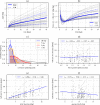A numerical study towards shape memory alloys application in orthotic management of pediatric knee lateral deviations
- PMID: 36747043
- PMCID: PMC9902535
- DOI: 10.1038/s41598-023-29254-z
A numerical study towards shape memory alloys application in orthotic management of pediatric knee lateral deviations
Abstract
Exerting a constant load would likely improve orthosis effectiveness in treating knee lateral deviations during childhood and early adolescence. Shape memory alloys are potential candidates for such applications due to their so called pseudoelastic effect. The present study aims to quantitatively define the applicable mechanical loads, in order to reduce treatment duration while avoiding tissular damage and patient discomfort. This is essential for performing a more efficient design of correction devices. We use a patient-specific finite elements model of a pediatric knee to determine safe loading levels. The achievable correction rates are estimated using a stochastic three-dimensional growth model. Results are compared against those obtained for a mechanical stimulus decreasing in proportion to the achieved correction, emulating the behavior of conventional orthoses. A constant flexor moment of 1.1 Nm is estimated to change femorotibial angle at a rate of (7.4 ± 4.6) deg/year (mean ± std). This rate is similar to the achieved by more invasive growth modulation methods, and represents an improvement in the order of 25% in the necessary time for reducing deformities of (10 ± 5) deg by half, as compared with conventional orthoses.
© 2023. The Author(s).
Conflict of interest statement
The authors declare no competing interests.
Figures






References
-
- Peterson HA. Physeal Injury Other than Fracture. Springer; 2012.
-
- Mallet, J. F. & Lechevallier, J. Chirurgie et orthopédie du genou de l’enfant, Monographie du Groupe d’étude en orthopédie pédiatrique, Sauramps médical, Montpellier (1993).
-
- Rozbruch SR, Ilizarov S. Limb Lenghthening and Reconstruction Surgery. Informa Healthcare; 2007.
Publication types
MeSH terms
Substances
LinkOut - more resources
Full Text Sources
Research Materials

